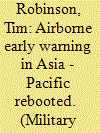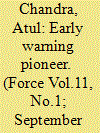|
|
|
Sort Order |
|
|
|
Items / Page
|
|
|
|
|
|
|
| Srl | Item |
| 1 |
ID:
100456


|
|
|
| 2 |
ID:
125965


|
|
|
|
|
| Publication |
2013.
|
| Summary/Abstract |
Embraer's journey with the Indian Airborne Early Warning & Control (AEW&C) programme began in February 2005, when a Memorandum of Understanding (MoU) was signed between the company and Defence Research and Development Organisation (DRDO), to develop a new AEW&C platform for the Indian Air Force (IAF).
The decision to select EMB 145 Intelligence, Surveillance and Reconnaissance (ISR) platform was taken based on Embraer's experience with the complex systems integration expertise for this class of airborne platform. The contract for three EMB 145 AEW&C platforms was signed in July 2008, the contract including a comprehensive logistics package covering training, technical support, spare parts, and ground support equipment
|
|
|
|
|
|
|
|
|
|
|
|
|
|
|
|
| 3 |
ID:
124672


|
|
|
|
|
| Publication |
2013.
|
| Summary/Abstract |
Over the years the naval air arm has grown from a modest force to a full-fledged operational arm with an inventory of more than 200 aircraft. These include fighters, helicopters, maritime reconnaissance aircraft and Unmanned Aerial Vehicles (UAVs) with the capability to support the entire spectrum of maritime operations covering all dimensions of naval warfare. The navy's air arm operates from aircraft carriers, ships and a large number of naval airfields located across the Indian Littorals.
In May this year, naval aviation marked its 60 years of existence with the commissioning of its Air Squadron (Black Panthers) equipped with MiG 29K fighter jets for Carrier borne operations. This was followed by the induction of Boeing P-81 Poseidon MR-ASW aircraft and finally, in a historic development with far-reaching operational consequences, the Indian Navy took delivery of INS Vikramaditya. The acquisition of this 44,570 tonne carrier marks a new phase in India's quest to become a true blue water navy and is likely to have generated more than a passing interest within the People's Liberation Army Navy (PLA Navy) and across the rest of the Continent. These developments will place the Indian Navy at par with Russian and US navies as far as hardware is concerned.
In the fighter jet category for operating out of aircraft carriers, the naval aviation has two squadrons of the Sea Harrier which operate from INS Viraat. These were acquired by the Indian Navy in the mid Eighties and these jets had also operated ex INS Vikrant. Action was initiated to get additional Sea Harrier jets from Britain when the same were decommissioned by the Royal Navy, but the proposal did not fructify due to technical glitches. The proposal for a mid-life upgrade in the late Nineties was cancelled when the decision was taken to purchase MiG-29K jet fighters to be deployed aboard the INS Vikramaditya.
As the Harriers are expected to remain in service with the navy till 2015, limited upgrades are being done by Hindustan Aeronautics Limited (HAL). The indigenously produced Kiran (jet fighter trainer), which is currently being used for training, is likely to be phased out following the induction AJT Hawk jet trainers. The Kirans have been part of the elite Naval Aerobatic Display Team, 'The Sagar Pawans'.
In the Long Range Maritime Reconnaissance stream, the navy presently operates eight Tupolev Tu-142 aircraft which entered service in 1988. Upgrade of the aircraft is in process to extend its service life. These aircraft operate from INS Rajali and INS Hansa. In the Medium Range category, the navy has the Islander aircraft inducted into the navy in 1976 - these aircraft are vintage and need immediate replacement. In the Short Range category, the navy operates the HAL-built Dornier aircraft which continues to meet the surveillance and reconnaissance requirements of the navy.
Helicopters form a key element of a naval fleet at sea due to its ability to easily operate from frigate size ships and carry out diverse roles from anti-submarine warfare (ASW) to electronic warfare (EW), airborne early warning (AEW) and search and rescue (SAR). The Indian Navy operates a helicopter fleet consisting of the Sea King (ASW), Kamov 28 and 31 (ASW) and the modified Chetak-MATCH (Mid Air Torpedo Carrying Helicopter). In addition, they have a fleet of Chetak helicopters for shipborne operations. These helicopters are old and need replacement/upgrades. The HAL manufactured Dhruv (naval variant) was inducted into the air arm in March 2002. However, the navy found the Dhruv unsuitable for its role as an ASW platform. The Kamov-31 AEW helicopters acquired from Russia in the Nineties has proved to be a versatile platform for airborne operations at sea; more numbers are likely to be inducted.
|
|
|
|
|
|
|
|
|
|
|
|
|
|
|
|
|
|
|
|
|